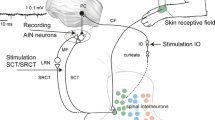Summary
1. Climbing fibre responses (CFRs) were evoked by limb nerve stimulation and recorded from the cerebellar surface in barbiturate anaesthetized cats. Climbing fibres were activated at frequencies of usually 2.5–7.5 Hz for periods of 15–30 s, after which the stimulation frequency was reduced to below 1 Hz. 2. The high-frequency stimulation induced a strong depression of CFR-amplitude, lasting up to 60 s. The magnitude of this depression was dependent on both the frequency and the duration of the high-frequency stimulation. 3. The depression occurred in the c1, c2 and c3 zones of the pars intermedia and in the x zone in the vermis but not in the b zone in the vermis. 4. Recordings of olivary reflex responses demonstrated that the depression occurred in the inferior olive. 5. It is suggested that the inhibition of the inferior olive occurs because the high-frequency stimulation leads to a disinhibition of neurones in the interpositus nucleus which inhibit the olivary neurones.
Similar content being viewed by others
References
Andersson G (1984) Mutual inhibition between olivary cell groups projecting to different cerebellar microzones in the cat. Exp Brain Res 54: 293–303
Andersson G, Hesslow G (1986) Evidence for an inhibitory action by cerebellar nuclear cells on the inferior olive. Neurosci Lett Suppl 26: S231
Andersson G, Hesslow G (1987) Activity of Purkinje cells and interpositus neurones during and after periods of high frequency climbing fibre activation in the cat. Exp Brain Res 67: 533–542
Andersson G, Oscarsson O (1978) Projections to lateral vestibular nucleus from cerebellar climbing fibre zones. Exp Brain Res 32: 549–564
Armstrong DM, Eccles JC, Harvey RJ, Matthews PBC (1968) Responses in the dorsal accessory olive of the cat to stimulation of hind limb afferents. J Physiol 194: 125–145
Armstrong DM, Harvey RJ (1966) Responses in the inferior olive to stimulation of the cerebellar and cerebral cortices in the cat. J Physiol 187: 553–574
Armstrong DM, Harvey RJ, Schild RF (1973) Cerebello-cerebellar responses mediated via climbing fibres. Exp Brain Res 18: 19–39
Carrea R, Guevara JA, Epstein R, Folino JC (1964) Periodic variations of cerebellar evoked electrocortical activity in the cat. Acta Neurol Latinoam 10: 189–220
Ekerot C-F, Larson B (1982) Branching of olivary axons to innervate pairs of sagittal zones in the cerebellar anterior lobe of the cat. Exp Brain Res 48: 185–198
Graybiel AM, Nauta HJW, Lasek RJ, Nauta WJH (1973) A cerebello-olivary pathway in the cat: an experimental study using autoradiographic tracing techniques. Brain Res 58: 205–211
Groenewegen HJ, Voogd J (1977) The parasagittal zonation within the olivocerebellar projection. I. Climbing fibre distribution in the vermis of cat cerebellum. J Comp Neurol 174: 417–488
Ito M, Obata K, Ochi R (1966) The origin of cerebellar-induced inhibition of Deiters neurones. II. Temporal correlations between the trans-synaptic activation of Purkinje cells and the inhibition of Deiters neurones. Exp Brain Res 2: 350–364
Ito M (1984) The cerebellum and neuronal control. Raven Press, New York
Llinás R, Baker R, Sotelo C (1974) Electrotonic coupling between neurons in cat inferior olive. J Neurophysiol 37: 560–571
McCrea RA, Bishop GA, Kitai ST (1978) Morphological and electrophysiological characteristics of projection neurons in the nucleus interpositus of the cat cerebellum. J Comp Neurol 181: 397–420
Miller S, Oscarsson O (1970) Termination and functional organization of spino-olivocerebellar paths. In: Fields WS, Willis WD (eds) The cerebellum in health and disease. Warren H Green, St Louis
Nelson B, Barmack NH, Mugnaini E (1984) A GABAergic cerebello-olivary projection in the rat. Soc Neurosci Abstr 10, 161: 7
Oscarsson O, Sjölund B (1977) The ventral spino-olivocerebellar system in the cat. I. Identification of five paths and their termination in the cerebellar anterior lobe. Exp Brain Res 28: 469–486
Rawson JA, Tilokskulchai K (1981) Suppression of simple spike discharges of cerebellar Purkinje cells by impulses in climbing fibre afferents. Neurosci Lett 25: 125–130
Tolbert DL, Massopoust LC, Murphy MG, Young PA (1976) The anatomical organization of the cerebello-olivary projection in the cat. J Comp Neurol 170: 525–544
Author information
Authors and Affiliations
Rights and permissions
About this article
Cite this article
Andersson, G., Hesslow, G. Inferior olive excitability after high frequency climbing fibre activation in the cat. Exp Brain Res 67, 523–532 (1987). https://doi.org/10.1007/BF00247285
Received:
Accepted:
Issue Date:
DOI: https://doi.org/10.1007/BF00247285




